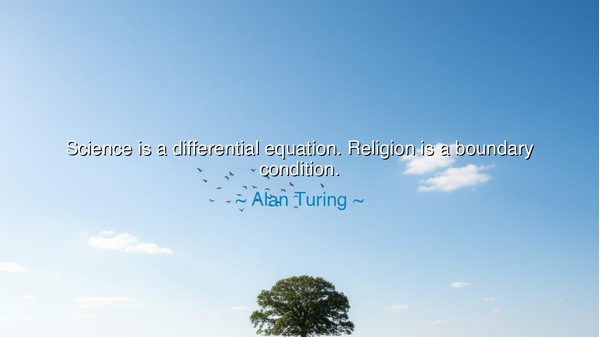
Science is a differential equation. Religion is a boundary






“Science is a differential equation. Religion is a boundary condition.” — so spoke Alan Turing, the brilliant mathematician and father of modern computing, whose mind bridged the worlds of logic and mystery. Beneath these words lies not only the thought of a scientist, but the meditation of a philosopher — one who saw in the structure of the universe a harmony between reason and faith, between discovery and meaning. Turing, who helped decipher the unbreakable codes of war and later probed the enigma of artificial intelligence, was no stranger to paradox. In this line, he expresses the eternal dance between knowledge and wonder, between what can be calculated and what must simply be believed.
To understand his words, we must first recall what they mean. A differential equation is the heart of motion and change — it describes the unfolding of things through time, the evolution of systems under the laws of nature. It is the mathematical embodiment of process, of cause and effect. The boundary condition, on the other hand, defines the limits within which that equation can operate — it gives form and meaning to the infinite possibilities of calculation. In short, science tells us how the universe moves; religion tells us why it matters. Without the differential equation, there is no motion; without the boundary, there is no definition. The one without the other is incomplete.
Turing’s quote arose from the depth of his dual nature — the man of logic who also wrestled with the mystery of existence. He had spent his life uncovering patterns, decoding systems, and revealing the hidden logic of the world. Yet he knew that even the most perfect equation cannot answer the human cry of “What is the purpose?” For him, science was the grand machinery of the cosmos — the mathematics of life unfolding in elegance and precision — but religion, or what he called the “boundary condition,” was the mystery that frames it, the unseen reason that gives meaning to the machine. It is the edge where knowledge ends and wonder begins.
We might see the same truth in the life of Isaac Newton, whose discovery of gravity changed the world forever. Newton was a man of profound science, yet also a man of deep religious reflection. He saw in every law of nature the handwriting of the divine. When he calculated the motions of the planets, he believed he was glimpsing the thoughts of God. For Newton, as for Turing, science was the equation — but God was the boundary, the principle that ordered the cosmos and held it in moral harmony. Thus, even the greatest minds of reason have bowed before mystery, recognizing that knowledge without reverence becomes hollow.
Turing’s metaphor also warns us of imbalance. A world governed only by equations — by science without boundary — becomes mechanical, soulless, and without compassion. But a world of boundaries without inquiry — religion without reason — becomes stagnant and blind. The two must coexist as partners in the same pursuit of truth. Science explores the how, but faith keeps alive the question of why. In this way, the human mind and the human heart remain whole, each correcting the other’s excess. Where science brings humility before the vastness of what can be known, religion brings humility before the vastness of what can never be known.
And yet, Turing’s own life is a testament to this struggle. Despite his unmatched brilliance, he suffered at the hands of a society unable to reconcile its own moral boundaries with the truths of human nature. He was persecuted for who he was, even as he gave the world the tools that would one day change it. In his quiet defiance and enduring curiosity, we see both the equation and the boundary at work — the scientist seeking order, and the human being searching for meaning. Perhaps it was this dual awareness that led him to such wisdom: that truth without mercy, logic without love, is an incomplete creation.
So, my child, what can we learn from this union of reason and reverence? Let science teach you precision, and let faith teach you perspective. Seek understanding, but never lose awe. Build your equations, but remember the boundary that gives them purpose. When you look at the stars, let your mind measure their distances, but let your heart feel their silence. To live wisely is to walk the line between these two — to think as a scientist, but to wonder as a poet; to measure the world, but to love it still.
Thus, Alan Turing’s wisdom calls us to harmony: that we may pursue knowledge without arrogance, and seek meaning without fear. For the universe is both equation and mystery, law and love, motion and boundary — and only when we honor both do we begin to see it, as Turing did, in its full and sacred light.






AAdministratorAdministrator
Welcome, honored guests. Please leave a comment, we will respond soon